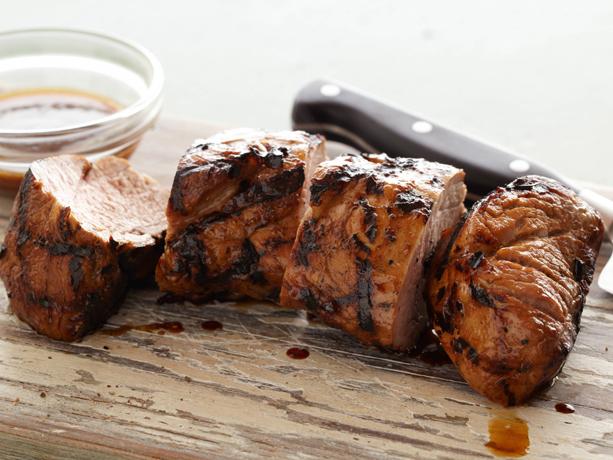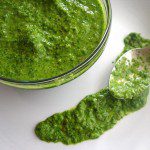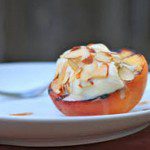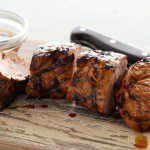Take It Outside: Grilling with Chef David Guas
By • October 28, 2014 0 1821

Chef and Television Host David Guas on his New Orleans Roots and the Fundamentals of Grilling
The reason chef David Guas never left the Washington area is because he missed New Orleans. Guas is the celebrated chef and owner of Bayou Bakery, Coffee Bar & Eatery, a vibrant tribute to Gulf Coast culinary tradition located in the Courthouse neighborhood of Arlington. A second eatery on Capitol Hill is slated to open this fall. He is also the host of Travel Channel’s new original series “American Grilled,” which premiered this month. The competition show pits grill masters from all walks of life against one another in regional, outdoor cooking challenges.
Guas’ career took off in his hometown of New Orleans. He worked in the pastry kitchen at the acclaimed Windsor Court Hotel under legendary chef and restaurateur Jeff Tunks. When Tunks opened DC Coast in1998, his flagship restaurant in Washington, Guas was recruited as head pastry chef. He later moved on to work as a corporate pastry chef for Passion Food Hospitality, developing the dessert menus for each of Tunks’ subsequent four restaurants.
With regular appearances on NBC’s Today Show, as well as guest slots on the Food Network and Cooking Channel, Guas has built a cult-like following as a champion of New Orleans culinary heritage. His 2009 cookbook, “DamGoodSweet – Desserts to Satisfy Your Sweet Tooth, New Orleans Style,” was a James Beard Award Finalist and was named one of Food & Wine’s Best New Dessert Cookbooks. He has been hailed by The Washington Post, The New York Times and Washingtonian magazine, and has been featured in every foodie magazine you can think to name.
But talking to him, you might never know of his acclaim. Chock it up to the humble values of a southern heritage, but his vast and broad-ranging achievements are equal only to his modesty, pragmatism and good nature.“Bayou Bakery started as a simple concept,” he said. “I wanted something that represented my home to keep me from moving back home. There was a real opportunity here, to represent New Orleans, Louisiana, and the Gulf Coast south in general. The more you do this for a living, the more you realize how unique southern food is. New Orleans is probably one of the most unique cities on the planet in terms of its cultural milieu. So what better way to be prideful and fill my own personal void than to celebrate the culture of the city that I’m from.”
The food in Bayou Bakery is unforgettable. From small-plate southern classics like housemade cheese straws, deviled eggs and pimento cheese to the olive-rich “muff-a-lotta” sandwich piled high with salami, mortadella and smoked ham, everything on the menu is bound to the traditions of regional American cuisine. If you don’t venture in one day for a cup of their rich coffee and an order of crispy, sugar-caked beignets, you are missing out on one of the truly great food adventures in Washington. About half of the menu is also based on seasonality. They are currently offering a radish plate with feta dip, a roasted beet salad and a chilled soup with avocados and local cucumbers.
As to why he chose this approach to his flagship restaurant, Guas has a simple and heart- felt answer. “It’s not until you get out into the world that you find out about where you’re from,” he says. “Researching for the cookbook, digging deeper to discover facts, the history and stories to food, I just fell back in love with New Orleans.”This concept of local heritage is also the foundation for his Travel Channel show, “American Grilled.” “I’m not on the professional barbecue circuit,” Guas says with a laugh. “I haven’t been going around to competitions winning trophies. I grew up grilling with my dad every weekend, and I know my way around proteins. But what I do get is the culture of it, the character and the heritage.”
The show offers an interesting perspective. So much of today’s food culture leans more and more toward local and regional ancestral kitchen traditions, focusing less on haute cuisine and more on authenticity and historical context. This show takes this mission to the next level bringing people on to the show that aren’t even professional chefs. The show is not just promoting someone’s restaurant. Instead, they are going to cities and towns around the country and finding the best grillers in the area, regardless of background—be it a hog-roasting mechanic from Galax,
Virginia or a Louisiana fisherman with the secret ingredients for perfect grilled shrimp.
“The show is very relative to where we are as a society today,” Guas says. “There is an energy and passion among restaurateurs toward knowing where your food comes from, understanding its local character. And, frankly, the barbecue world is full of characters. So it’s built into our show in a very natural way. These contestants could be your neighbor—it’s a show that’s sort of made up of a bunch of nobodys, including myself. It is a game show, but it’s fun, raw and very local, organic, and feels very handmade.”
In order to prepare for each episode, Guas researched the grilling specialties of the featured towns and cities. “It was important to learn about and integrate each area’s regional character and represent it the right way,” he says. “As a chef, that what was so exciting for me, the regional personality of each place. I love New Orleans food, but learning new things about new cities and sharing that information with an audience is really just a dream job.” While he might not be a “competitive griller,” Guas knows how to work a grill. Below is his four-step process to no-frills, good grilling done right.
Bayou Bakery, Coffee Bar & Eatery is located at 1515 N Courthouse Road, Arlington, Va. Travel Channel is currently airing new episodes of “American Grilled” on Wednesdays at 9 p.m., with a chance to catch them again Sundays at 10 p.m. For more information visit www.BayouBakeryVa.com.
Guas on Grilling
Acid, Salt, Herbs and Rest
Like any chef who cooks for his family, Guas is “not in recipe mode” when he’s manning the grill at home. “To me, the grill represents being off the clock. It’s not so rigid as pastry cooking, it’s not looking at your watch. It’s a beer in one hand, a cigar in the other, and the coals prepping while the meat and vegetables rest by the side.” “A lot of the things I’ve done on the grill for the past two decades, it’s just doing what I love to do and not thinking about it,” he admits. “For instance, my father raised me on a charcoal grill and that’s how I continue to do it.”
However, Guas has a few simple steps for making sure your dinner comes off the grill the right way every time. “There are four things I think we underestimate,” he says. “Acid, salt, herbs and rest.” Here’s the breakdown.
Acid
“Citrus brightens up everything,” Guas says, “whether it’s lime or lemon, or even a blend of orange. I always work it into my grilling.” Guas often grills his citrus fruit, cutting them in half and putting them cut-side down for a minute or two to give it a char. As well as using it to drizzle on meat and grilled vegetables, he even uses grilled citrus for things like grilled lime mojitos or smoked lemonade with bourbon.
Salt
Proteins, depending on what they are, need a good amount of coarse, quality heavy sea salt. “Everyone knows it, but nothing brings out flavor like salt,” Guas says. “Salt the things in advance, about a teaspoon per pound—and do it well in advance—and you’ll just watch those flavors come out when you take it off the grill.”
Herbs
“Herbs are often overlooked,” says Guas. “But they are the best way to engrain a sense of seasonality into your grilling. Rosemary and thyme are great fall and winter herbs, while chives, chervil, cilantro and parsley scream of the warmer months. Our herb gardens are probably within 15 feet of our grills and still we forget to use them.” Herbs can be used fresh as garnish, or in the form of a condiment, like a basil pesto or a chimichurri sauce—just throw the marinade in a gallon Ziploc bag with chicken or fish and let it rest anywhere between a couple hours and a day. Herbs can also be mixed with other ingredients, for instance, chopped up rosemary ground in a mortar and pestle with garlic, salt and lime, and used in a marinade for a tougher meat like skirt steak.
Rest
Most of us underestimate resting time for a protein, warns Guas. “If you’ve got a freshly grilled, 18-ounce, bone-in cut ribeye, it’s a sad day for us all to watch the juices run off into the cutting board. Trust me on this: all protein needs resting time after it cooks to cool down and let the juices settle back in and redistribute.” When cooking, heat drives the moisture toward the center of the meat. When given time to cool after cooking, the liquid is redistributed as the protein molecules relax and are able to reabsorb some moisture. This is why all the juice drips out of your meat if you cut it too soon after coming off the heat. “Everything should rest for at least a few minutes,” Guas says, “but make sure to build in ten to twelve minutes of resting time for a big piece of meat.”
Grilled Peaches
Ingredients
6 each Peaches, halved
Procedure
Make sure the surface of your grill is clean. Place the half slices of peaches on the grill over direct heat, skin side down first to give it a quick browning. Then open face-side of the peach to grill until browning and caramelization occurs from the natural sugars. Remove from grill and reserve at room temperature.
Mascarpone Cream
Ingredients
4 ounces Mascarpone Cream
.25 cup Whipping Cream
2 tbs Powdered Sugar
Garnish
Ingredients
1 drizzle Honey, approx. 2 tsp.
2 ounces Pecans, toasted & crumbled
Procedure
Using a hand-mixer or stand-up mixer with the whisk attachment, on medium speed, blend together the mascarpone cheese and 1 tablespoon of powdered sugar until light and fluffy. Spoon into a separate bowl and set aside. Pour the cream and the remaining sugar into the original mixing bowl and blend on high-speed just until stiff peaks form, about a minute or two. Turn the mixer off and carefully fold the whipped cream into the mascarpone mixture.
Grilled Pork Tenderloin with Guava BBQ Sauce
David Guas, Chef & Owner, Bayou Bakery and Coffee Bar & Eatery
Yields: approximately 4 servings
For the Brine
Ingredients
.75 cup Salt, kosher
.25 cup Sugar, granulated
1 cup Water, hot
3 cups Water, cold
1 each Pork tenderloin, approx. 2 pounds
1 cup Woodchips, pre-soaked cherry
Procedure
Place the salt, sugar, and hot water for the brine together in an 8-quart container and whisk until the salt and sugar have dissolved. Once mixed together, add the cold water and place the tenderloin in the brine mixture. Cover and refrigerate for 6-8 hours.
For the Guava BBQ Sauce
Ingredients
12 ounces Guava paste, cut into small cubes
.25 cup Dark rum
.5 cup Orange juice
.25 cup Lime juice
2 tablespoons Creole mustard
2 each Garlic cloves, minced
4 tablespoons Steen’s Cane Syrup
1 tablespoon Crystal hot sauce
1 teaspoon Salt, kosher
Sauce Procedure
In a small 2-quart saucepan, combine all ingredients. Simmer over low heat, stirring occasionally with a wooden spoon until guava paste dissolves and ingredients are nice and thick, approx. 5-20 minutes.
Grilling Procedure
Prepare your grill 30 minutes before your pork is ready to remove from the brine. Once removed from the brine, pat dry with paper towels, season lightly with olive oil, kosher salt and cracked black pepper. Grill over direct heat. Place tenderloin down on grill giving it 5 minutes on each side depending on the heat of your coals. Using a brush, baste your sauce liberally on each side of the pork. Place on indirect heat. Next sprinkle pre-soaked woodchips on the coals. Continue to baste every five minutes or so for 20 minutes until your internal temperature reaches 160-165 degrees Fahrenheit. When you remove pork tenderloin from the grill, brush heavily with remaining sauce as you pull off the grill. Place on cutting board and allow meat to rest, sealing in the juices, for at least 15 minutes prior to cutting.
Assembly
Place 2-3 halves of peaches on a plate with a tablespoon-sized dollop of the mascarpone cream atop the peaches. Garnish with a drizzle of honey [approximately 2 teaspoons per dish] and crumbled toasted pecans. [Toast pecans whole at 375 degrees Fahrenheit for roughly 5 minutes; allow to cool before crumbling.]
Chimichurri
“Start to finish in five minutes. Put it in a mason jar and it’s done, and will last two or three weeks if sealed properly. I love it with chicken, fish, and even charred vegetables.”
Ingredients
1 Cup flat leaf, Italian Parsley
¼ Cup cilantro
Sm. Handful red onion, chopped
¼ – ½ cup red wine vinegar
Salt (to taste, tsp or less)
Black Pepper (to taste)
Red Chili Flakes (a pinch)
½ Cup good Olive Oil
Garlic, chopped (to taste, about two cloves)
Procedure
Puree all ingredients in a food processor, then transfer to a bowl and let sit for at least fifteen minutes to let the flavors come together. Use as a marinade, or drizzle on top of the finished product.
- Grilled Pork Tenderloin with Guava BBQ Sauce




